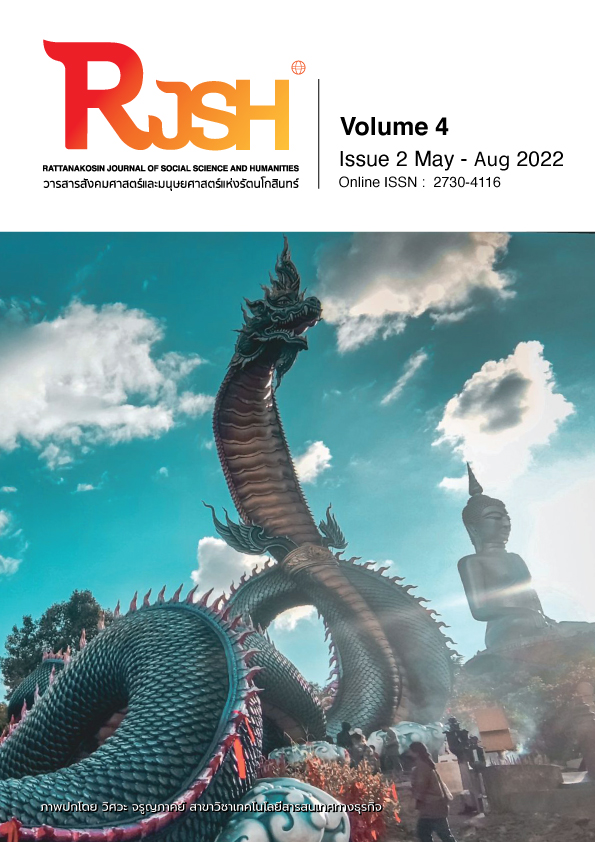The Condition and The Physical Characteristics of Public Rest-Houses (Salaklanghon) in the Sathingphra Peninsula
Main Article Content
Abstract
The objective of this research was to investigate the condition and the physical characteristics of public rest-houses (Salaklanghon) in the Sathingphra peninsula. Field data were collected by using interviews, observations, and taking photos of public rest-houses seen during 2016-2020. The data were analyzed, compiled, and presented in a descriptive analysis form. The results of the study can be summarized as follows: There are currently 157 public rest-houses (Salaklanghon) in the Sathingphra peninsula. 122 of them are in good condition and 35 are in disrepair. The characteristics of public rest-houses are divided into 3 main components: the base, the middle, and the upper parts. The sizes of the public rest-houses considered by the number of pillars were found that the smallest public rest-houses have 4 pillars, the most common size has 9-12 pillars and the largest has 30 pillars. The characteristics of the public rest-houses are mostly an open hall building, raised floor with a low basement. The floor of the public rest-houses may be elevated to two or three levels with partial walls. As for the roof, there are both gable and hipped shapes. Roofing materials include clay, cement, and zinc tiles. The public rest-houses have a wooden structure that uses wood from palm trees, which the villagers call it "Mai Node". The logging methods of the public rest-houses are different. Some houses use nails or screws in wood jointing, while others use notching or drilling wood and inserting wooden latches or dowels instead.
Article Details
The content within the published articles, including images and tables, is copyrighted by Rajamangala University of Technology Rattanakosin. Any use of the article's content, text, ideas, images, or tables for commercial purposes in various formats requires permission from the journal's editorial board.
Rajamangala University of Technology Rattanakosin permits the use and dissemination of article files under the condition that proper attribution to the journal is provided and the content is not used for commercial purposes.
The opinions and views expressed in the articles are solely those of the respective authors and are not associated with Rajamangala University of Technology Rattanakosin or other faculty members in the university. The authors bear full responsibility for the content of their articles, including any errors, and are responsible for the content and editorial review. The editorial board is not responsible for the content or views expressed in the articles.
References
กรมศิลปากร. (2522). การศึกษาสภาพแวดล้อมบริเวณแหล่งขุดค้นโบราณคดีสทิงพระและการสำรวจแหล่งโบราณคดีใกล้เคียง. รายงานทางวิชาการ, กรุงเทพฯ: กองโบราณคดี กรมศิลปากร.
กาญจน์ เพียรเจริญ. (2543). ศึกษาศาลากลางหนในบริเวณคาบสมุทรสทิงพระ จังหวัดสงขลา. วิทยานิพนธ์ศิลปศาสตรมหาบัณฑิต, มหาวิทยาลัยทักษิณ.
ฉัตรทิพย์ นาถสุภา และ พูนศักดิ์ ชานิกรประดิษฐ์. (2540). เศรษฐกิจหมู่บ้านภาคใต้ฝั่งตะวันออกในอดีต. กรุงเทพฯ: สำนักพิมพ์สร้างสรรค์.
ธราพงศ์ ศรีสุชาติ. (2529). สทิงพระ: ชุมชนโบราณ. ใน ธราพงศ์ ศรีสุชาติ, สารานุกรมวัฒนธรรมไทยภาคใต้ พ.ศ.2529 เล่ม 9 (หน้า 3656-3663). กรุงเทพฯ: สถาบันทักษิณคดีศึกษามหาวิทยาลัยศรีนครินทรวิโรฒ สงขลา.
สุธิวงศ์ พงศ์ไพบูลย์. (2529). ศาลากลางหน. ใน สุธิวงศ์ พงศ์ไพบูลย์, สารานุกรมวัฒนธรรมไทยภาคใต้ พ.ศ.2529 เล่ม 8 (หน้า 3407). กรุงเทพฯ: สถาบันทักษิณคดีศึกษา มหาวิทยาลัย ศรีนครินทรวิโรฒ สงขลา.


